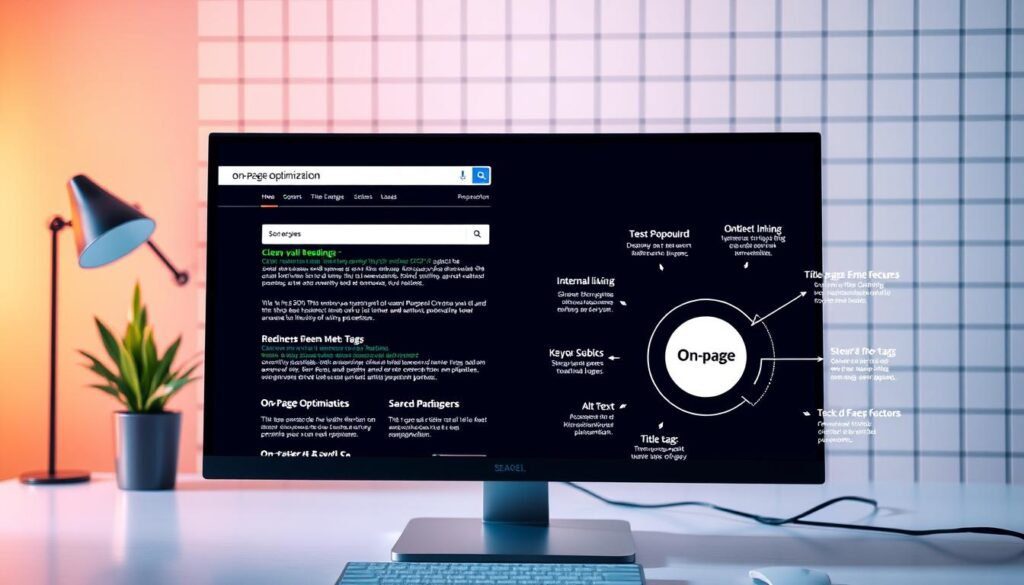Did you know that 40% of young people now use apps like TikTok and Instagram to find information instead of traditional search engines? This shift is reshaping how businesses approach marketing and reach their audiences. As users explore platforms beyond Google, the concept of optimizing for a fragmented search landscape has become essential.
At Macro Webber, we specialize in performance marketing that drives revenue. Our strategies are designed to adapt to this evolving environment, ensuring your brand stays visible wherever your audience is searching. Whether it’s social media, voice assistants, or emerging platforms, we help you leverage the right keywords and tactics to stay ahead.
This section will introduce you to the core principles of modern search optimization. You’ll learn why adapting to these changes is crucial and how Macro Webber’s expertise can transform your approach. Let’s dive into the strategies that will set your brand apart in this new era of search.
Key Takeaways
- Younger audiences are increasingly using social media platforms for search purposes.
- Traditional search engines are no longer the only focus for optimization.
- Macro Webber’s performance marketing strategies are tailored to this new landscape.
- Adapting to fragmented search behavior is essential for brand visibility.
- Modern optimization involves leveraging multiple platforms and tools.
Understanding the Evolving Landscape of Search Everywhere
The way people find information online is undergoing a dramatic transformation. Platforms like TikTok and Instagram are no longer just for entertainment—they’ve become essential tools for discovery. This shift is reshaping how brands approach their content strategies and connect with audiences.
Changing User Behavior Across Platforms
Younger audiences are leading this change. Instead of relying solely on traditional search engines, they’re turning to social media for answers. For example, TikTok’s algorithm allows users to find video content that feels personalized and engaging. This behavior is influencing how brands structure their site and optimize for visibility.
Recent data shows that 40% of young people now use apps like TikTok and Instagram as their primary search tools. This trend highlights the importance of adapting your approach to meet users where they are.
The Shift from Traditional to Multi-Platform Search
Gone are the days when Google was the only focus. Today, users engage with multiple platforms to find information. For instance, after watching a TikTok video, many users conduct additional research on Google before making a purchase. This multi-platform behavior impacts how search engines index content and rank results.
Here’s a quick comparison of traditional vs. multi-platform search behavior:
| Aspect | Traditional Search | Multi-Platform Search |
|---|---|---|
| Primary Tool | TikTok, Instagram, YouTube | |
| Content Format | Text-based | Video-driven |
| User Engagement | Keyword-focused | Algorithm-driven |
At Macro Webber, we understand these changes and tailor our performance marketing strategies to fit this new landscape. By leveraging platforms like TikTok and Instagram, we help brands stay visible and relevant in an ever-evolving digital world.
“The future of search is not about one platform—it’s about meeting users wherever they are.”
As search habits continue to evolve, adapting your strategy is no longer optional—it’s essential. Whether it’s optimizing for video content or ensuring your site is mobile-friendly, staying ahead requires a proactive approach.
Defining Core SEO Principles in a Fragmented Environment
In today’s fragmented digital world, SEO principles are more critical than ever. As search behaviors shift across platforms, the fundamentals of structured data, mobile-first design, and on-page optimization remain essential. These principles ensure your content is discoverable, regardless of where users are searching.
At Macro Webber, we specialize in merging traditional SEO techniques with modern strategies. This approach allows us to adapt to the evolving search landscape while maintaining the integrity of proven practices. By focusing on user experience and page optimization, we help brands stay visible and competitive.
Fundamental Concepts for New SEO Strategies
Understanding the basics is key to navigating today’s search environment. Here’s how core principles are being updated for a fragmented world:
- Structured Data: Ensures search engines can interpret your content across platforms.
- Mobile-First Design: Prioritizes seamless experiences for mobile users, who dominate search traffic.
- On-Page Optimization: Focuses on improving page elements like titles, meta descriptions, and multimedia.
These principles are not just about ranking higher—they’re about delivering value to your audience. For example, optimizing for mobile ensures your page loads quickly and is easy to navigate, which directly impacts user satisfaction.
By balancing historical tactics with new approaches, you can meet the challenges of today’s search landscape. Whether it’s adapting to video-driven platforms or ensuring your site is mobile-friendly, the core principles of SEO remain your foundation for success.
Top Search Everywhere Optimisation Strategies for High-Value Keywords
In the ever-changing digital world, focusing on the right terms can make or break your online presence. High-value terms are those that drive conversions and align closely with customer intent. Understanding their unique characteristics is the first step to optimizing your strategy.
What Makes High-Intent Terms Unique?
High-intent terms are different because they signal a strong readiness to take action. For example, someone searching for “buy running shoes online” is closer to making a purchase than someone searching for “best running shoes.” This intent is what sets these terms apart.
According to industry experts, terms with transactional intent often lead to higher conversion rates. They also provide valuable datum about customer behavior, helping you refine your marketing efforts.
Data-Driven Insights and Best Practices
At Macro Webber, we use proprietary datum to identify terms that convert. Our approach combines analytics with real-world insights to ensure your campaigns are effective. Here are some best practices we recommend:
- Focus on product-specific terms that align with customer needs.
- Analyze search behavior to understand the way users interact with your content.
- Use tools like Google Ads and Search Console to track performance.
By focusing on high-intent terms, you can increase ROI and create more efficient campaigns. Here’s a comparison of high-intent vs. low-intent terms:
| Aspect | High-Intent Terms | Low-Intent Terms |
|---|---|---|
| Conversion Rate | High | Low |
| Search Intent | Transactional | Informational |
| ROI Potential | Significant | Limited |
Adopting a strategic approach to term selection can transform your optimization efforts. By leveraging datum and focusing on the right product-related terms, you can stay ahead in the competitive digital landscape.
Strategic Keyword Research for a Modern SEO Approach
Effective keyword research is the backbone of any successful SEO strategy. It’s not just about finding popular terms—it’s about identifying those that align with your audience’s needs and drive measurable results. At Macro Webber, we combine proprietary data with advanced tools to uncover terms that signal genuine buyer intent.

Mining Proprietary and Client Data
Our approach begins with analyzing internal datasets and client-specific information. This allows us to identify patterns and trends that traditional tools might miss. For example, by examining how a person interacts with a website, we can pinpoint terms that lead to conversions.
We also integrate external tools like Google Ads and Search Console to validate our findings. This dual approach ensures that our keyword recommendations are both data-driven and actionable.
Identifying High-Intent Search Terms
High-intent terms are those that indicate a readiness to take action. For instance, someone searching for “buy running shoes online” is more likely to convert than someone searching for “best running shoes.” These terms are crucial for driving revenue and improving ROI.
Here’s how we balance high-volume terms with those that convert:
- Focus on product-specific terms that align with customer needs.
- Analyze search behavior to understand how users interact with your content.
- Refine your keyword focus using real-world client data.
“The right keywords don’t just drive traffic—they drive results.”
By leveraging Macro Webber’s proprietary data, you can transform your keyword research from a guessing game into a strategic advantage. Whether you’re optimizing for a business or a personal brand, our methods ensure you stay ahead in the competitive digital landscape.
Adapting Your SEO Tactics for Multiple Platforms
As digital platforms evolve, the way users discover content is shifting dramatically. Social media platforms like TikTok and Instagram are no longer just for entertainment—they’ve become essential tools for search. This change requires a new approach to SEO tactics that goes beyond traditional methods.
At Macro Webber, we specialize in creating strategies that adapt to these changes. Our forward-thinking approach ensures your brand stays visible wherever your audience is searching. Whether it’s through video content or influencer partnerships, we help you stay ahead of the curve.
Optimizing for Social Media as Search Engines
Social media platforms are now acting as search engines. For example, TikTok’s algorithm prioritizes engaging video content, making it a powerful tool for discovery. To succeed, your strategy must include optimizing for these platforms.
Here are some key tactics:
- Use hashtags and keywords that align with your audience’s search behavior.
- Create short, engaging videos that answer common questions or showcase your products.
- Collaborate with influencers to expand your reach and credibility.
Integrating TikTok and Video Content Strategies
Video content is one of the most effective ways to engage users. Platforms like TikTok and YouTube prioritize videos that keep viewers watching. This means your strategy should focus on creating high-quality, relevant content.
Here’s a comparison of traditional SEO vs. video-driven SEO:
| Aspect | Traditional SEO | Video-Driven SEO |
|---|---|---|
| Content Format | Text-based | Video-focused |
| Engagement | Keyword-driven | Algorithm-driven |
| Platforms | TikTok, YouTube, Instagram |
“The future of SEO lies in meeting users where they are—whether it’s on social media or through video content.”
By integrating these tactics into your strategy, you can enhance your organic search performance and stay relevant in a rapidly changing digital landscape. At Macro Webber, we’re here to help you navigate these shifts and achieve long-term success.
Enhancing On-Page Elements for Maximum Visibility
Your website’s on-page elements play a crucial role in how users and search engines interact with your content. Optimizing these elements ensures your name stands out in search results and keeps visitors engaged. At Macro Webber, we focus on creating user-friendly experiences that drive results.

Content Structuring and User Experience Considerations
Effective content structuring starts with clear headlines and subheadings. These elements guide users through your website, making it easy to find what they need. For example, a well-organized page with meaningful headings can improve engagement and reduce bounce rates.
Meta descriptions are another key factor. They provide a brief summary of your page’s content, encouraging users to click through. A compelling meta description can significantly boost your click-through rate (CTR).
Here’s how to optimize your on-page elements:
- Use descriptive headlines that include your target keywords.
- Break content into short paragraphs for better readability.
- Add internal links to guide users to related pages.
At Macro Webber, we emphasize the importance of thoughtful design. A clean layout and intuitive navigation can enhance user experience and keep visitors on your site longer.
| Element | Best Practices | Impact |
|---|---|---|
| Headlines | Include keywords, keep them concise | Improves readability and SEO |
| Meta Descriptions | Write unique, engaging summaries | Boosts CTR |
| Internal Links | Link to relevant, high-authority pages | Enhances navigation and rankings |
“A well-structured page not only ranks better but also keeps users engaged and coming back for more.”
By focusing on these elements, you can create a website that performs well in search results and delivers a seamless user experience. At Macro Webber, we’re here to help you achieve both.
Technical SEO Strategies for Better Crawlability
Your website’s technical foundation plays a critical role in how search engines and users interact with it. Without a solid technical base, even the best content can struggle to rank. At Macro Webber, we focus on refining site architecture and implementing structured data to ensure your site is easily discoverable and indexed.
Technical SEO involves optimizing the backend elements of your site to improve crawlability and indexing. This includes everything from site structure to the use of structured data. By addressing these areas, you can ensure search engines understand your topics and rank your pages effectively.
Optimizing Site Architecture for Crawl Efficiency
A well-organized site architecture is essential for search engine bots to navigate your pages. Ideally, every page should be no more than three clicks away from the homepage. This structure not only improves crawlability but also enhances user experience.
Here are some key steps to optimize your site architecture:
- Use a logical hierarchy with clear categories and subcategories.
- Implement internal linking to guide bots and users to important pages.
- Ensure your XML sitemap is up-to-date and submitted to search engines.
Leveraging Structured Data for Better Indexing
Structured data helps search engines understand the context of your content. By adding schema markup, you can provide additional information about your pages, such as product details, reviews, or event dates. This can lead to rich snippets in search results, boosting your click-through rates.
For example, adding product schema can display pricing and availability directly in search results. This not only improves visibility but also drives higher engagement.
“Structured data is a powerful tool for enhancing your site’s search performance and user experience.”
At Macro Webber, we use advanced tools like Google Search Console and Screaming Frog to conduct technical audits. These audits help identify issues like broken links, slow-loading pages, and missing metadata. By addressing these problems, we ensure your site is optimized for both search engines and users.
Here’s a quick comparison of technical SEO best practices:
| Element | Best Practice | Impact |
|---|---|---|
| Site Architecture | Logical hierarchy, internal linking | Improves crawlability and UX |
| Structured Data | Schema markup for rich snippets | Boosts CTR and indexing |
| Technical Audits | Regular checks for errors | Ensures optimal performance |
By focusing on these technical strategies, you can create a website that ranks higher and delivers a seamless experience. At Macro Webber, we’re here to help you build a strong technical foundation for long-term success.
Aligning On-Page and Off-Page Optimization Efforts
Achieving a seamless integration of on-page and off-page optimization is key to unlocking your website’s full potential. These two efforts work together to enhance visibility, improve rankings, and drive organic traffic. At Macro Webber, we specialize in combining these strategies to deliver measurable results.

On-page optimization focuses on improving elements within your website, such as content, meta tags, and internal linking. Off-page optimization, on the other hand, involves external resources like backlinks and social signals. When aligned correctly, these features create a powerful synergy that boosts your SEO performance.
Effective Link Building and Anchor Text Practices
Link building remains one of the most effective off-page strategies. It involves acquiring high-quality backlinks from authoritative websites. These links act as votes of confidence, signaling to search engines that your content is valuable.
Anchor text, the clickable text in a hyperlink, plays a crucial role in conveying contextual relevance. For example, using descriptive anchor text like “best SEO practices” helps search engines understand the linked page’s topic. This effort enhances both user experience and search engine rankings.
Here are some best practices for link building and anchor text:
- Focus on acquiring links from websites with high domain authority.
- Use varied anchor text to avoid over-optimization and penalties.
- Leverage internal linking to guide users and search engines to important pages.
Proper allocation of internal resources is also essential. For instance, dedicating time to create high-quality content that naturally attracts backlinks can yield long-term benefits. At Macro Webber, we ensure your efforts are strategically aligned for maximum impact.
Real-World Examples of Combined Strategies
Combining on-page and off-page tactics can lead to significant improvements. For example, a well-optimized blog post with internal links and structured data can attract backlinks from industry blogs. This dual approach amplifies your SEO signal and drives sustained organic growth.
Here’s a comparison of on-page and off-page optimization:
| Aspect | On-Page Optimization | Off-Page Optimization |
|---|---|---|
| Focus | Internal elements (content, meta tags) | External factors (backlinks, social signals) |
| Impact | Improves user experience and relevance | Enhances authority and trustworthiness |
| Tools | Content management systems, SEO plugins | Link-building tools, social media platforms |
“The true power of SEO lies in the harmony between on-page and off-page efforts.”
By integrating these strategies, you can create a robust SEO framework that adapts to the evolving digital landscape. At Macro Webber, we’re here to help you maximize your resources and achieve long-term success.
Tapping into User Engagement and Behavior Signals
Understanding how users interact with your site is crucial for SEO success. Recent studies show that engagement metrics like time on site, click-through rates, and bounce rates directly impact search rankings. At Macro Webber, we use data-driven insights to decode these signals and refine your strategy.
User behavior provides valuable clues about what works and what doesn’t. For example, a high bounce rate might indicate that your content doesn’t match the user’s intent. By analyzing these metrics, you can identify areas for improvement and adjust your approach.
Here’s how engagement signals influence SEO:
- Time on Site: Longer sessions suggest users find your content valuable, which boosts rankings.
- Click-Through Rates (CTR): A high CTR indicates your meta descriptions and titles are compelling.
- Bounce Rate: A low bounce rate shows users are engaging with multiple pages.
At Macro Webber, we help you interpret these signals to create content that resonates with your audience. For instance, if users spend more time on video content, we’ll focus on producing more videos to meet their needs.
Behavior signals also reveal trends in user preferences. By tracking how users navigate your site, you can optimize your language and content to better address their questions. This approach ensures your site remains relevant and engaging.
Here’s a comparison of key engagement metrics and their impact:
| Metric | What It Measures | SEO Impact |
|---|---|---|
| Time on Site | Duration of user sessions | Indicates content relevance |
| CTR | Percentage of clicks on search results | Reflects title and meta description effectiveness |
| Bounce Rate | Percentage of single-page visits | Shows content alignment with user intent |
“User engagement is not just a metric—it’s a source of actionable insights for improving your SEO strategy.”
By leveraging these signals, you can create a site that not only ranks higher but also delivers a better user experience. At Macro Webber, we’re here to help you turn engagement data into tangible results.
Building Influencer and Creator Partnerships
In today’s digital age, influencer partnerships are reshaping how brands connect with their audiences. Collaborating with creators has become a key strategy for driving organic search performance and building brand credibility. At Macro Webber, we specialize in leveraging these partnerships to enhance your company’s visibility and reach.

Leveraging Authentic Content for SEO Gains
Authenticity is the cornerstone of successful influencer collaborations. When creators align with your brand’s values, their content resonates more deeply with audiences. This authenticity not only boosts engagement but also drives high-quality backlinks and social signals, which are critical for SEO.
Here’s how influencer partnerships can benefit your industry:
- Enhance brand authenticity and trust through genuine endorsements.
- Expand reach by tapping into the creator’s established audience.
- Drive organic traffic and improve search rankings through backlinks.
Identifying the right creators is essential. Look for influencers whose content aligns with your company’s mission and audience. Tools like social media analytics can help you evaluate their engagement rates and audience demographics.
“Influencer partnerships are not just about reach—they’re about building trust and driving meaningful engagement.”
To maximize the impact of these collaborations, integrate them into your overall SEO strategy. For example, co-create content that targets specific keywords or topics relevant to your industry. This approach ensures that your influencer campaigns contribute to your search performance.
Here’s a comparison of traditional marketing vs. influencer-driven marketing:
| Aspect | Traditional Marketing | Influencer-Driven Marketing |
|---|---|---|
| Reach | Broad but less targeted | Niche and highly targeted |
| Engagement | Lower interaction rates | Higher interaction rates |
| SEO Impact | Limited backlinks | High-quality backlinks |
Monitoring the success of your influencer partnerships is crucial. Use tools like Google Analytics to track traffic, conversions, and engagement metrics. This data will help you refine your strategy and ensure long-term growth.
At Macro Webber, we help you navigate the evolving landscape of influencer marketing. By aligning these partnerships with your SEO goals, we ensure your company stays ahead in a competitive digital world.
Utilizing Analytics for Data-Driven Optimization
Modern SEO requires more than intuition—it demands measurable proof. At Macro Webber, we transform complex data into clear optimization signals that drive results. Our approach combines cutting-edge tools with human expertise to reveal what truly works.
Voice of Customer Insights and Conversion Metrics
Understanding your audience starts with their digital footprints. Tools like Google Analytics 4 track engagement rates beyond simple page views. These metrics show whether visitors actually interact with your content.
Key customer signals to monitor:
- Engagement rate: Sessions lasting over 10 seconds with multiple pageviews
- Conversion paths: How users move from search to action
- Content gaps: Topics your competitors cover but you don’t
For example, a low click-through rate in Search Console often means your meta descriptions need work. We help you interpret these patterns to refine your messaging.
Continuous Performance Monitoring
SEO isn’t a one-time effort—it’s daily refinement. Our team establishes benchmarks for:
| Metric | Tracking Frequency | Optimization Impact |
|---|---|---|
| Keyword rankings | Weekly | High |
| Core Web Vitals | Monthly | Critical |
| Backlink profile | Quarterly | Strategic |
“What gets measured gets improved. Our analytics dashboards turn complex data into clear impact.”
Regular audits catch issues before they hurt rankings. Slow pages get optimized. Broken links get fixed. This day-to-day vigilance keeps your site performing at peak levels.
At Macro Webber, we pair automated monitoring with human analysis. This combination spots trends machines might miss—like seasonal search pattern shifts. The result? Strategies that adapt as fast as search algorithms change.
Optimizing for Local and Mobile User Experiences
Mobile devices have transformed how users interact with local businesses, making optimization essential. With over 90% of consumers using smartphones for product research, your website must deliver seamless experiences across devices. At Macro Webber, we specialize in crafting strategies that cater to mobile users and regional needs, ensuring your brand stays visible wherever your audience is searching.

Mobile optimization isn’t just about responsive design—it’s about speed and usability. Google recommends mobile sites load in under one second to maintain user engagement. Slow-loading pages can deter potential customers, reducing your chance of conversions. By focusing on mobile-first design, you can create a website that performs well in search engine rankings and keeps users engaged.
Here are actionable tips to optimize for mobile and local search:
- Use short, descriptive titles (50-60 characters) to avoid truncation on mobile devices.
- Keep meta descriptions under 105 characters for better visibility in search engine results.
- Leverage structured data to enhance your eligibility for rich snippets.
Local search strategies are equally important. Google prioritizes businesses with complete and accurate information in their Google Business Profile. Updating your business hours, adding photos, and responding to reviews can significantly improve your local visibility. These steps not only boost your rankings but also build trust with potential customers.
“A well-optimized local and mobile strategy turns online searchers into in-store visitors.”
At Macro Webber, we combine expert insights with data-driven strategies to help you dominate local and mobile search. By targeting regional keywords and adapting your site’s structure, we ensure your brand captures every chance to connect with highly motivated users. Whether it’s optimizing for mobile speed or enhancing your local presence, our approach delivers measurable results.
Here’s a quick comparison of mobile vs. desktop optimization:
| Aspect | Mobile Optimization | Desktop Optimization |
|---|---|---|
| Load Speed | Under 1 second | Under 3 seconds |
| Content Format | Short paragraphs, white space | Longer, detailed content |
| User Engagement | High interaction rates | Moderate interaction rates |
By focusing on these strategies, you can create a website that not only ranks higher but also delivers a superior user experience. At Macro Webber, we’re here to help you navigate the evolving landscape of local and mobile search, ensuring your brand stays ahead in a competitive digital world.
Migrating Traditional SEO Practices into Future Strategies
The digital landscape is evolving rapidly, and so must your SEO strategies. As traditional techniques give way to emerging trends, integrating new methodologies with legacy practices has become essential for sustained success. At Macro Webber, we champion innovative, future-proof techniques that ensure your brand stays ahead in a competitive online environment.
Modernizing traditional SEO practices involves more than just adopting new tools—it’s about blending historical insights with cutting-edge trends. While core principles like structured data and mobile-first design remain relevant, adapting to new platforms and user behaviors is equally critical. For example, optimizing for google search now includes preparing for AI Overviews, which are expected to dominate 30% of queries by 2025.
Integrating Emerging Trends with Legacy SEO
Transitioning from old strategies doesn’t mean abandoning what works. Instead, it’s about enhancing proven methods with modern innovations. For instance, while keyword research remains foundational, understanding how users interact with search results on platforms like TikTok and YouTube is equally important. These platforms prioritize engagement signals like watch time and likes, which can significantly impact your rankings.
Here’s how to merge historical insights with new trends:
- Focus on mobile-first indexing, as Google now prioritizes the mobile version of your site for rankings.
- Leverage AI tools to analyze data faster and refine your strategy in real-time.
- Optimize for voice search by ensuring consistent NAP (Name, Address, Phone) information across directories.
Real-life examples show how established companies have successfully navigated this migration. For instance, businesses that embraced short-form video content saw a significant boost in engagement and conversions. By adapting to these trends, they captured broader search results and stayed relevant in a changing digital world.
| Aspect | Traditional SEO | Future SEO |
|---|---|---|
| Focus | Text-based content | Video and multimedia-driven |
| Platforms | TikTok, YouTube, voice assistants | |
| Engagement | Keyword rankings | Watch time, likes, comments |
“The future of SEO lies in blending the old with the new—retaining core principles while embracing emerging trends.”
By integrating these strategies, you can create a robust SEO framework that adapts to the evolving digital landscape. At Macro Webber, we’re here to help you navigate this transition and achieve long-term success.
Overcoming Internal Collaboration Challenges
Breaking down internal barriers is essential for maximizing your digital marketing potential. Organizational silos often hinder effective strategies, especially when integrating SEO and social media efforts. At Macro Webber, we specialize in fostering cross-departmental collaboration to enhance overall performance and drive better results.
Aligning SEO and Social Media Goals
One of the biggest challenges is aligning the goals of SEO and social media teams. While SEO focuses on improving search engine rankings, social media aims to boost engagement and brand awareness. These objectives can seem conflicting, but they’re actually complementary when integrated correctly.
Here’s how to bridge the gap:
- Establish shared KPIs that reflect both SEO and social media objectives.
- Encourage regular communication between teams to align strategies.
- Use data from both channels to identify opportunities for collaboration.
Practical Steps for Improved Coordination
Effective collaboration requires more than just shared goals—it demands actionable steps. Start by creating a unified content calendar that includes both SEO and social media campaigns. This ensures consistency and maximizes the impact of your efforts.
Here’s a comparison of traditional vs. integrated approaches:
| Aspect | Traditional Approach | Integrated Approach |
|---|---|---|
| Goal Alignment | Separate objectives | Shared KPIs |
| Communication | Limited interaction | Regular meetings |
| Results | Fragmented outcomes | Cohesive performance |
“Collaboration isn’t just about working together—it’s about achieving better results through shared efforts.”
Case Studies: Real-World Success
Many companies have successfully bridged internal gaps to achieve significant marketing gains. For example, a leading e-commerce brand integrated its SEO and social media strategies, resulting in a 30% increase in organic traffic and a 20% boost in social engagement. This success was driven by consistent communication and a unified approach to content creation.
At Macro Webber, we help businesses replicate this success by breaking down silos and fostering collaboration. Our expertise ensures your teams work together seamlessly, driving measurable improvements in search engine rankings and social media performance.
Best Practices for Incorporating Multimedia Content
Multimedia content has become a cornerstone of modern SEO, driving both user engagement and search rankings. From optimized images to engaging videos, these elements enhance your website’s appeal and performance. At Macro Webber, we specialize in leveraging multimedia to create impactful SEO strategies that resonate with users and search engines alike.
Image Optimization and Alt Text Importance
Images are more than just visual aids—they’re opportunities to improve your search engine visibility. Properly optimized images load faster, enhancing user experience and reducing bounce rates. One key aspect is using descriptive alt text, which helps search engines understand the content of your images.
Here’s how to optimize your images effectively:
- Use alt text that includes relevant keywords to improve accessibility and SEO.
- Compress images to ensure they load quickly without sacrificing quality.
- Choose responsive designs that adapt to different screen sizes.
For example, an e-commerce site that optimizes product images with alt text can see a significant boost in organic traffic. This approach ensures your website remains accessible and user-friendly.
Video Optimization for Enhanced Engagement
Video content is a powerful tool for capturing user attention and improving engagement. Platforms like YouTube and TikTok prioritize videos that keep viewers watching, making it essential to optimize your video content for both users and search engines.
Here are actionable tips for video optimization:
- Use descriptive titles that include target keywords to improve discoverability.
- Add transcripts to make your videos accessible and searchable.
- Include metadata like tags and descriptions to enhance visibility.
At Macro Webber, we help brands create video content that aligns with user intent and drives measurable results. For instance, a tutorial video with a clear title and transcript can rank higher in search results, attracting more viewers.
“Multimedia content isn’t just about aesthetics—it’s about creating a seamless experience that boosts engagement and rankings.”
By integrating these strategies, you can ensure your multimedia elements contribute effectively to your overall SEO performance. At Macro Webber, we’re here to help you navigate the evolving landscape of multimedia optimization, ensuring your brand stays ahead in a competitive digital world.
Conclusion
The future of SEO lies in adapting to evolving trends while staying rooted in proven practices. As user behaviors shift across platforms, integrating traditional and modern techniques is essential for achieving high-quality, customer-centric results. From optimizing for voice search to leveraging multimedia content, the strategies discussed in this article provide actionable steps to enhance your online presence.
At Macro Webber, we specialize in performance-driven solutions that align with these evolving trends. Our approach ensures your brand remains visible and competitive in a fragmented digital landscape. By focusing on customer needs and delivering high-quality experiences, we help you drive meaningful engagement and measurable results.
Ready to take your SEO strategy to the next level? Connect with Macro Webber today for expert insights and tailored support. Together, we can transform your approach and achieve long-term success.



